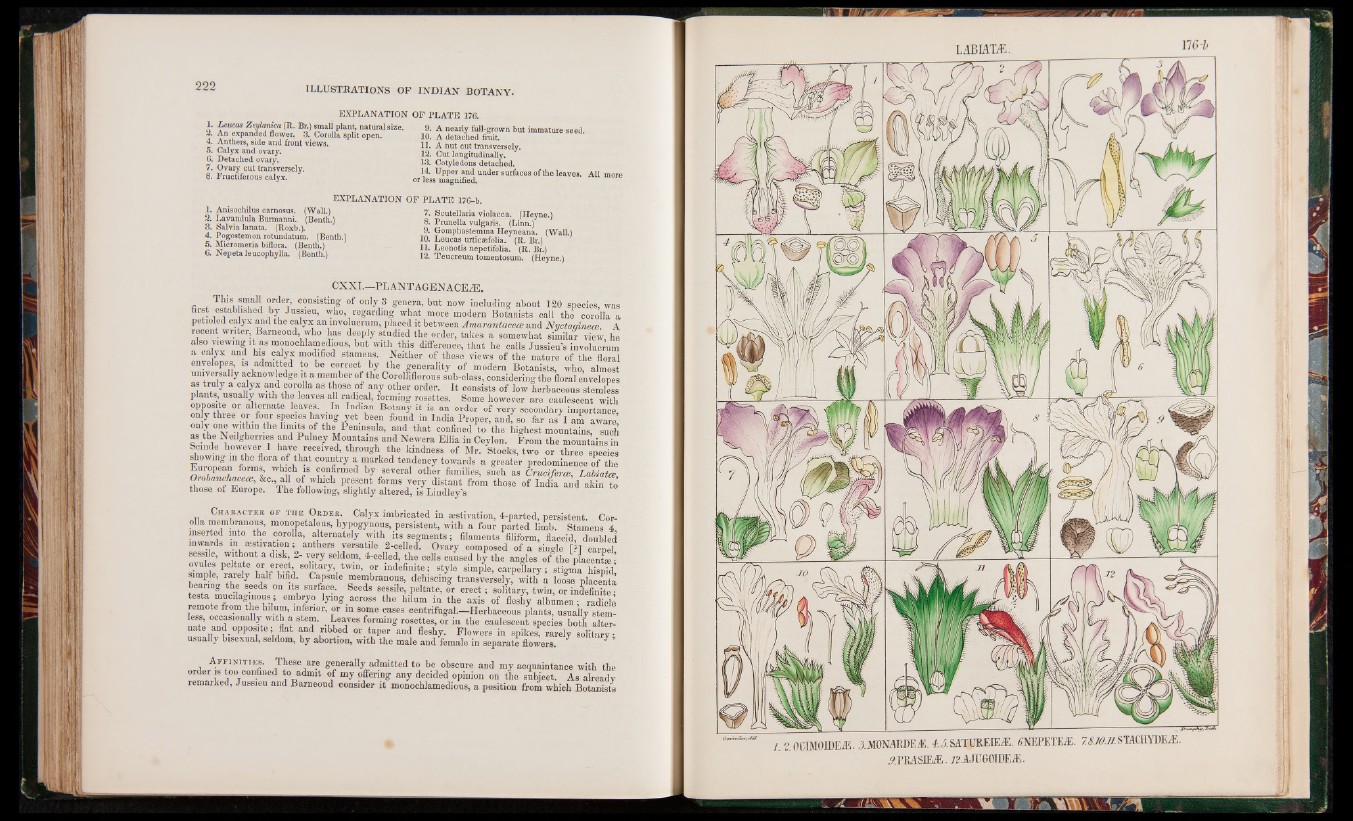
EXPLANATION OF PLATE 176.
1. Leucas Zeylanica (R. Br.) small plant, natural size.
2. An expanded flower. 3. Corolla split open.
4. Anthers, side and front views.
5. Calyx and ovary.
6. Detached ovary.
7. Ovary cut transversely.
8. Fructiferous calyx.
EXPLANATION
1. Anisochilus carnosus. (Wall.)
2. Lavandula Burmanni. (Benth.)
3. Salvia lanata. (Roxb.).
4. Pogostemon rotundatum. (Benth.)
5. Micromeria biflora. (Benth.)
6. Nepeta leucophylla. (Benth.)
9. A nearly full-grown but immature seed.
10. A detached fruit.
11. A nut cut transversely.
12. Cut longitudinally.
13. Cotyledons detached.
14. Upper and under surfaces of the leaves. All more
or less magnified.
OF PLATE 176-b.
7. Scutellaria violacca. (Heyne.)
8. Prunella vulgaris. (Linn.)
9. Gomphastemma Heyneana. (Wall.)
10. Leucas urticsefolia. (R. Br.)
11. Leonotis nepetifolia. (R. Br.)
12. Teucreum tomentosum. (Heyne.)
CXXI.—PLANTAGENACEAE.
This small order, consisting of only 3 genera, but now including about 120 species, was
hrst established by Jussieu, who, regarding what more modern Botanists call the corolla a
petioled calyx and the calyx an mvolucrum, placed it between Jmarantacece and Nyctaqinece. A
recent writer Barneoud who has deeply studied the order, takes a somewhat similar view he
also viewing it as monochlamedious, but with this difference, that he calls Jussieu’s involucrum
a ca yx and his calyx modified stamens. Neither of these views of the nature of the floral
envelopes, is admitted to be correct by the generality of modern Botanists, who, almost
universally acknowledge it a member of the Corolliflorous sub-class, considering the floral envelopes
as truly a calyx and corolla as those of any other order. It consists of low herbaceous stemless
plants, usually with the leaves all radical, forming rosettes. Some however are caulescent with
opposite or alternate leaves. In Indian Botany it is an order of very secondary importance,
on y three or four species having yet been found in India Proper, and, so far as I am aware
onlyonewdhinthehmdsof the Pemnsuia, and that confined to the highest mountains, such
as the Neilghernes and Pulney Mountains and Newera Ellia in Ceylon. From the mountains in
Scinde however I have received, through the kindness of Mr. Stocks, two or three species
showing in the flora of that country a marked tendency towards a greater predominence of the
European forms, which is confirmed by several other families, such as Cruciferce, Labiatce,
Orobanchacece, 8ic.,all of which present forms very distant from those of India and akin to
those of Europe. The following, slightly altered, is Lindley’s
C h a r a c t e r o f t h e O r b e r . Calyx imbricated in estivation, 4-parted, persistent. Corolla
membranous, monopetalous, hypogynous, persistent, with a four parted limb. Stamens 4
inserted into the corolla, alternately with its segments; filaments filiform, flaccid, doubled
inwards in aestivation; anthers versatile 2-celled. Ovary composed of a single [?I carpel
sessile, without a disk, 2- very seldom, 4-ceiled, the cells caused by the angles of the p acente
ovules peltate or erect, solitary, twin, or indefinite; style simple, carpellary; stigma hispTd’
simple, rarely half bifid. Capsule membranous, dehiscing transversely, with a loose placenta
bearing the seeds on its surface. Seeds sessile, peltate, or erect; solitary, twin, or indefinite ■
testa mucilaginous; embryo lying across the hilum in the axis of fleshy albumen; radicle
remote from the hilum, inferior, or in some eases centrifugal.—Herbaceous plants, usually stemless,
occasionally with a stem. Leaves forming rosettes, or in the caulescent spec es both alt“ -
nate and opposite; flat and ribbed or taper and fleshy. Flowers in spikes? rarely solitary-
usually bisexual, seldom, by abortion, with the male and female in separate flowers. J 7
A f f in i t i e s . These are generally admitted to be obscure and my acquaintance with the
order is too confined to admit of my .offering any decided opinion on the subject. As already
remarked, Jussieu and Barneoud consider it monochlamedious, a position from which Botanists
LABIATÆ. m - b
1 2.0CM0IDEÆ. .3.M0NARDEÆ. 4.ASATUREIEÆ. fiNEPETEÆ. 7.8.JO.I1.STACHYDEÆ
ÆFRASIEÆ. I2.AJUG0IDEÆ.